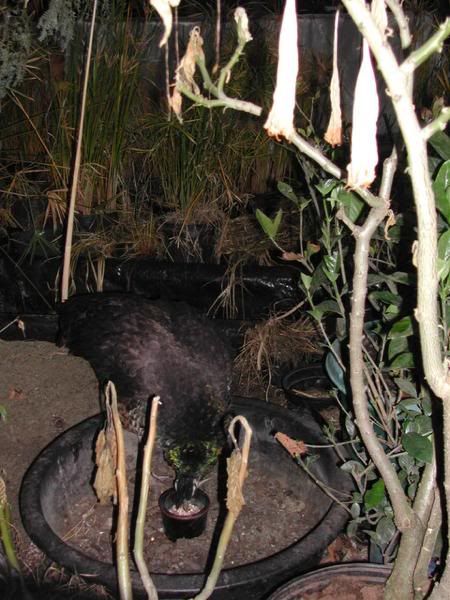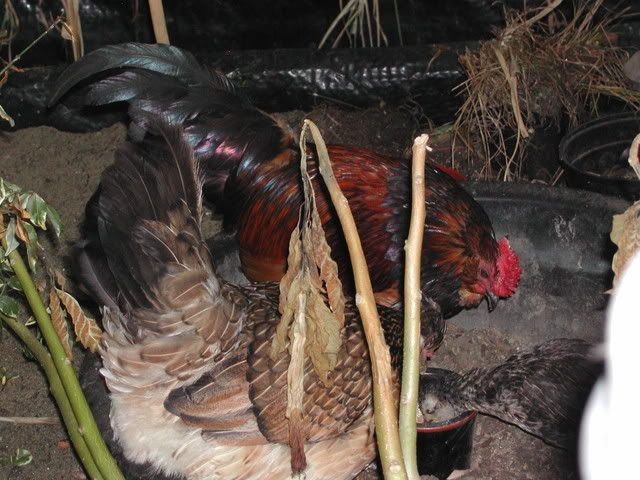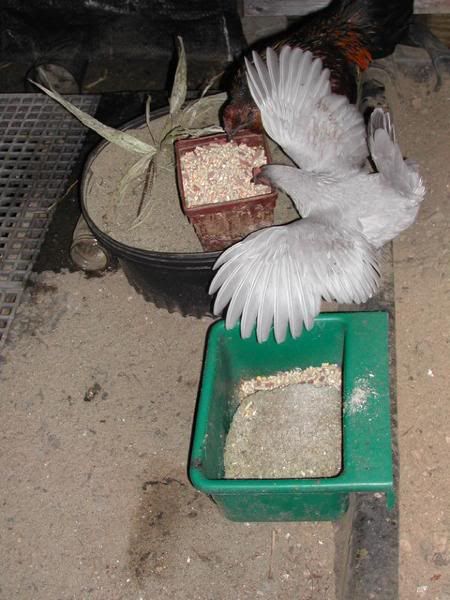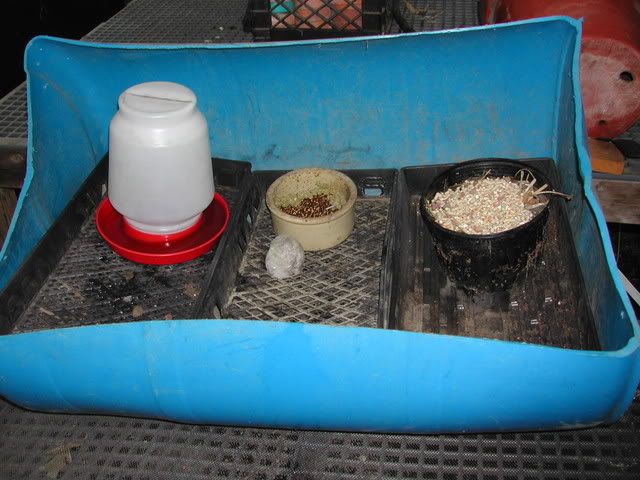
Navigation
Install the app
How to install the app on iOS
Follow along with the video below to see how to install our site as a web app on your home screen.
Note: This feature may not be available in some browsers.
More options
You are using an out of date browser. It may not display this or other websites correctly.
You should upgrade or use an alternative browser.
You should upgrade or use an alternative browser.
Getting Ready For Winter
- Thread starter Resolution
- Start date
Quote:
http://i875.photobucket.com/albums/ab316/Maahes_2010/Ayam/The Poultry Cote/predatorproff.jpg
It's primarily an issue of fecal/dander contamination. The closer the food is to the ground, the more likely it is to come into contact with environmental dust generated from the more or less strictly terrestrial activities like rake scratching and bill digging. Dander is of course largely deposited from nocturnal perches. Adding feed particulates to that mix is enhancing the environment for potentially deleterious bacterium.
Secondly, a feeding table helps make an enclosure more complex- more behaviorally stimulating while also obliging hens into more activity-
Birds breath through their bones to some extent and the more activity they have ( above the heavier dust layer ) the better.
Another challenge that leads me to this solution is my own ergonomic issues- namely- I know that I've got to keep these feeding areas clean enough for my family to eat off of.
If I have to bend down all the time I may get lazy from time to time (nevermind when you leave these chores to someone else with less conviction or concept). If I'm not looking directly at the waterers I may not appreciate how filthy they've become.
On that note, I find that any health problems are more immediately recognizable when the birds have to fly or jump up to a feeding station. I'm looking directly at them at waist or eye level-rather than looming over them.
You may find as well that territories are not so well demarcated on feeding tables as chickens tend to be more territorial over ground space than mid elevation tables and high elevation roosts.
Lastly, a feeding table creates more physical space, that is, the surface area that the birds can actually use- this basically increases the % of room the birds have to live in- something particularly useful during long winter months.
What great points you made, thank you, I understand much better now and completely agree. Thanks for putting it in perspective.
Plus, thinking on it, birds in the wild aren't subject to living and eating in the same small enclosed area that they do in coops. they have a huge range to travel.
http://i875.photobucket.com/albums/ab316/Maahes_2010/Ayam/The Poultry Cote/predatorproff.jpg
It's primarily an issue of fecal/dander contamination. The closer the food is to the ground, the more likely it is to come into contact with environmental dust generated from the more or less strictly terrestrial activities like rake scratching and bill digging. Dander is of course largely deposited from nocturnal perches. Adding feed particulates to that mix is enhancing the environment for potentially deleterious bacterium.
Secondly, a feeding table helps make an enclosure more complex- more behaviorally stimulating while also obliging hens into more activity-
Birds breath through their bones to some extent and the more activity they have ( above the heavier dust layer ) the better.
Another challenge that leads me to this solution is my own ergonomic issues- namely- I know that I've got to keep these feeding areas clean enough for my family to eat off of.
If I have to bend down all the time I may get lazy from time to time (nevermind when you leave these chores to someone else with less conviction or concept). If I'm not looking directly at the waterers I may not appreciate how filthy they've become.
On that note, I find that any health problems are more immediately recognizable when the birds have to fly or jump up to a feeding station. I'm looking directly at them at waist or eye level-rather than looming over them.
You may find as well that territories are not so well demarcated on feeding tables as chickens tend to be more territorial over ground space than mid elevation tables and high elevation roosts.
Lastly, a feeding table creates more physical space, that is, the surface area that the birds can actually use- this basically increases the % of room the birds have to live in- something particularly useful during long winter months.
What great points you made, thank you, I understand much better now and completely agree. Thanks for putting it in perspective.
Plus, thinking on it, birds in the wild aren't subject to living and eating in the same small enclosed area that they do in coops. they have a huge range to travel.
Quote:
You were obviously born knowing all...lucky for you.
http://i875.photobucket.com/albums/ab316/Maahes_2010/THE ISLAND/Resolution Overdrive/ego.jpg
?
I was referring to this logical question thread , which I assumed had been moderated out. This is due to the fact that I have too many windows open on my computer- that and the fact that I am a bit distracted with with work from my other real life.
No more coffee for you ChurchX3 !
p.s. I apologise for not answering your query. In the future, If I FAIL to answer a question just write me a personal note and remind me of that fact.
peaz
I apologize RESOLUTION....thought you were being critical of my question...i.e. inappropriate for this particular topic. I really do read and respect your topics and advise.
You were obviously born knowing all...lucky for you.
http://i875.photobucket.com/albums/ab316/Maahes_2010/THE ISLAND/Resolution Overdrive/ego.jpg
?
I was referring to this logical question thread , which I assumed had been moderated out. This is due to the fact that I have too many windows open on my computer- that and the fact that I am a bit distracted with with work from my other real life.
No more coffee for you ChurchX3 !
p.s. I apologise for not answering your query. In the future, If I FAIL to answer a question just write me a personal note and remind me of that fact.
peaz
I apologize RESOLUTION....thought you were being critical of my question...i.e. inappropriate for this particular topic. I really do read and respect your topics and advise.
- Thread starter
- #24
Quote:
I've written to best known American carpenter of the poop hammock and I'm sure he'll be responding shortly. I would try and describe how it all goes together- indeed should be able to as I designed the contraption- but alas mine brain is not a linear one. The poultry cote carpenters at Plymouth Colony Farm are going to be able to describe the poop hammock from an engineering stand point and they've tried out different shapes and sizes in different poultry enclosures.
As for your outdoor perches- might they be replaced with circular perches- for example- a wagon wheel suspended from the centre- a tire suspended from the centre- a home made branch wreath suspended from the centre-?
You'll need to secure these circular perches so that they don't swing widely when birds fly onto them. I prefer this design because it's easy to put an improvised poop hammock under them.
I believe the carpenters at Plymouth Colony Cote actually build them to spec. as well...
I've written to best known American carpenter of the poop hammock and I'm sure he'll be responding shortly. I would try and describe how it all goes together- indeed should be able to as I designed the contraption- but alas mine brain is not a linear one. The poultry cote carpenters at Plymouth Colony Farm are going to be able to describe the poop hammock from an engineering stand point and they've tried out different shapes and sizes in different poultry enclosures.
As for your outdoor perches- might they be replaced with circular perches- for example- a wagon wheel suspended from the centre- a tire suspended from the centre- a home made branch wreath suspended from the centre-?
You'll need to secure these circular perches so that they don't swing widely when birds fly onto them. I prefer this design because it's easy to put an improvised poop hammock under them.
I believe the carpenters at Plymouth Colony Cote actually build them to spec. as well...
Plus, thinking on it, birds in the wild aren't subject to living and eating in the same small enclosed area that they do in coops. they have a huge range to travel.
Absolutely correct. Thank you for pointing that out Rusty!
Absolutely correct. Thank you for pointing that out Rusty!
- Thread starter
- #25

Quote:
No worries CX3! I intimated as much. One of my favorite producers told me that my writing is opaque as butter milk.
Quote:
How do you recommend keeping the birds from soiling the feeding station?
I just ordered some UltraKibble and will be trying it out. It should be mixed with the scratch grains in the appropriate ratio by weight if I have understood correctly, not offered in separate bowls at the feeding station. The scratch grains at my local store are just cracked corn and oats mixed together. I could also mix my own scratch if I knew what grains were most preferred.
Also, what is your preferred set-up for watering the birds? I know you recommend cleaning them frequently, but do you recommend having the water at the feeding station or a separate station. ACV in the water?
Nipple style watering system or bowls? On the ground or on an elevated platform, etc. ?
Thank you in advance for any input. I appreciate your holistic approach and focus on preventive practices for maintaining a healthy flock.
How do you recommend keeping the birds from soiling the feeding station?
I just ordered some UltraKibble and will be trying it out. It should be mixed with the scratch grains in the appropriate ratio by weight if I have understood correctly, not offered in separate bowls at the feeding station. The scratch grains at my local store are just cracked corn and oats mixed together. I could also mix my own scratch if I knew what grains were most preferred.
Also, what is your preferred set-up for watering the birds? I know you recommend cleaning them frequently, but do you recommend having the water at the feeding station or a separate station. ACV in the water?
Nipple style watering system or bowls? On the ground or on an elevated platform, etc. ?
Thank you in advance for any input. I appreciate your holistic approach and focus on preventive practices for maintaining a healthy flock.
- Thread starter
- #27
Quote:
The birds can and will soil their feeding station to some extent. It depends on how it's designed. Here are a few inexpensive examples that we've thrown together over the years. Water is always kept on a table off the ground. I prefer to keep it as far away from the feeding table as possible.



This is probably my favorite design as it's very simple. A larger container filled with sand provides the bed within which a smaller feed bowl is placed.

Here's another set up- it's own unit.

Here is a foraging table where feeders are placed- its an elevated bed filled with sand. The birds can do spill feed into the foraging table sand bed and they do soil the sand as well. However, feed bowls are carried into the enclosure and placed on the foraging table - in different places- most of the feed stays in the bowl until it is ingested and the droppings are picked up when the bowls are collected after feeding.
The birds can and will soil their feeding station to some extent. It depends on how it's designed. Here are a few inexpensive examples that we've thrown together over the years. Water is always kept on a table off the ground. I prefer to keep it as far away from the feeding table as possible.



This is probably my favorite design as it's very simple. A larger container filled with sand provides the bed within which a smaller feed bowl is placed.

Here's another set up- it's own unit.

Here is a foraging table where feeders are placed- its an elevated bed filled with sand. The birds can do spill feed into the foraging table sand bed and they do soil the sand as well. However, feed bowls are carried into the enclosure and placed on the foraging table - in different places- most of the feed stays in the bowl until it is ingested and the droppings are picked up when the bowls are collected after feeding.
Last edited:
May I interrupt with a question, please?
This time of year pumpkins are plentiful. Is it recommended to feed pumpkins, squash, etc, seeds and all? I read (somewhere?) that the seeds needed some kind of treatment (cooked maybe?) before being fed to chickens.
This time of year pumpkins are plentiful. Is it recommended to feed pumpkins, squash, etc, seeds and all? I read (somewhere?) that the seeds needed some kind of treatment (cooked maybe?) before being fed to chickens.
- Thread starter
- #29
Quote:
Interrupt what? I think you're contributing to this thread, no?
Raw Pumpkins and Squash etc- guts and seeds are organic internal parasite control and extremely high in nutrients for all birds.
They do not need to be processed in any way.
Another seed for winter supplementation, especially for blue egg layers is the Chia .
Interrupt what? I think you're contributing to this thread, no?
Raw Pumpkins and Squash etc- guts and seeds are organic internal parasite control and extremely high in nutrients for all birds.
They do not need to be processed in any way.
Another seed for winter supplementation, especially for blue egg layers is the Chia .
- Sep 28, 2008
- 4,801
- 18
- 376


New posts New threads Active threads
-
Latest threads
-
-
-
Coop & run don’t smell, but lots of insects and potential rat issue
- Started by TeePants
- Replies: 6
-
-
-
-
Threads with more replies in the last 15 days
-
BYC's 52-week Photography Challenge. Week 1: (Jan 5-11, 2026). Theme: SUNSET
- Started by azurbanclucker
- Replies: 104
-
Open Contest Cutest Couples Photo Contest—Poultry Edition
- Started by Lacy Duckwing
- Replies: 102
-
BYC's 52-week Photography Challenge. Week 2: (Jan 12-18, 2026). Theme: "Flock Star!
- Started by Lacy Duckwing
- Replies: 77
-
Favorite Chicken Breed?
- Started by urlocalcrazychickenlady
- Replies: 61
-
-
×

